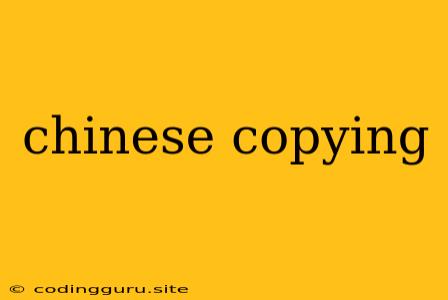The Complexities of "Chinese Copying": A Deep Dive into Cultural Influences and Innovation
The term "Chinese copying" often evokes strong reactions, fueling discussions about plagiarism, innovation, and cultural appropriation. But is it truly an accurate representation of the reality? Understanding the nuances of "Chinese copying" requires a deeper examination of its historical context, cultural influences, and the complexities of innovation in the 21st century.
Is "Copying" a Fair Assessment?
The concept of "copying" itself implies a direct and unethical appropriation of someone else's work without attribution. However, cultural exchange and the evolution of ideas are rarely linear processes. Throughout history, various cultures have borrowed and adapted ideas from one another, contributing to a rich tapestry of global innovation.
Consider the following:
- The Silk Road: This ancient trade route facilitated the exchange of goods, ideas, and technologies between the East and West for centuries. This cross-cultural pollination resulted in mutual influence and the development of new inventions.
- The Renaissance: This period in European history witnessed the rediscovery and reinterpretation of classical Greek and Roman knowledge. While some might argue that this was a form of "copying," it ultimately fueled a period of unprecedented artistic, scientific, and intellectual growth.
The Role of Cultural Influence
When analyzing "Chinese copying," it's crucial to consider the inherent cultural influences that shape innovation. Chinese culture places a strong emphasis on 传承 (chéngchuán) - transmission and 借鉴 (jièjiàn) - learning from others. This philosophy encourages a process of adaptation and improvement rather than outright plagiarism.
Here's an example:
- Chinese ceramics: The evolution of Chinese porcelain is a testament to this principle. While early forms were inspired by foreign influences, Chinese artisans constantly refined techniques and aesthetics, ultimately developing unique and distinctive styles.
The Rise of Chinese Innovation
In recent years, China has emerged as a major player in the global innovation landscape. Companies like Huawei, Alibaba, and Tencent have developed cutting-edge technologies that rival those of Western counterparts.
But how does this relate to "Chinese copying"?
It's important to note that Chinese innovation often involves a process of 学习 (xuéxí) - learning and 改进 (gǎijìn) - improvement. Chinese companies might initially "borrow" ideas from other countries but then invest heavily in research and development to create their own unique solutions.
Examples:
- Xiaomi smartphones: While early models drew inspiration from Apple iPhones, Xiaomi quickly developed its own software and hardware, creating a distinct brand identity.
- Alipay: This mobile payment platform started by adapting existing ideas from Western companies, but it rapidly expanded its features and functionalities, becoming a dominant force in China's digital economy.
The Ethical Dilemma
Despite the undeniable progress made by Chinese companies, the perception of "Chinese copying" persists. This often stems from concerns about intellectual property rights and the potential for unfair competition.
However, it's crucial to consider:
- The evolving nature of intellectual property: In a globalized world, ideas flow freely, and it's challenging to pinpoint the exact origin of an invention.
- The role of competition: Competition drives innovation, and China's rapid economic growth has challenged existing power structures in the global market.
Moving Forward
The debate surrounding "Chinese copying" is complex and multifaceted. It highlights the challenges of navigating cultural exchange, intellectual property rights, and the evolving landscape of innovation.
Here are some key takeaways:
- Cultural context matters: Understanding the cultural influences that shape innovation is crucial for avoiding biased assessments.
- Learning and adaptation are essential: Innovation often involves building upon existing ideas and adapting them to specific needs and contexts.
- Open dialogue is crucial: Engaging in respectful and constructive dialogue about these issues is vital for fostering global understanding and collaboration.
Conclusion
While the term "Chinese copying" may linger, it's crucial to move beyond simplistic generalizations and engage in a nuanced analysis of the complexities surrounding Chinese innovation. By acknowledging the role of cultural influence, embracing the principles of learning and adaptation, and promoting open dialogue, we can create a more informed and productive conversation about the future of global innovation.
